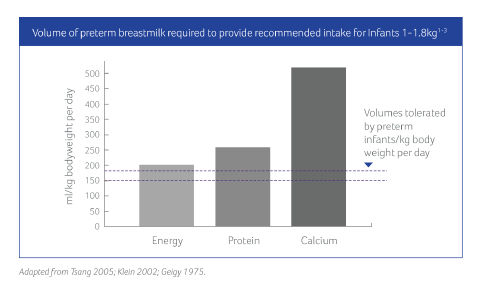Around 8% of babies are born prematurely in the UK1. Premature babies have very different nutritional requirements to full term infants as they need to attain the growth that would have occurred in utero, as well as achieve functional development2. Inspired by breastmilk, we are committed to delivering products and services to help preterm babies thrive through appropriate nutritional support.
Introduction
The first 1,000 days from conception to toddlerhood is a crucial window of opportunity and meeting the nutritional needs of infants during this period will positively influence short and long-term health outcomes3,4.
In the UK, around 60,000 infants are born every year before 37 weeks’ gestation5, of which 10% have a birth weight of less than 1,000g6,7. This means they have very specific dietary requirements.
Preterm nutritional needs and challenges
Preterm infants will face a multitude of challenges including: respiratory complications, poor thermoregulation, problems with gastrointestinal (GI) tract, low body stores of many nutrients and other medical complications8.
The final trimester of pregnancy is particularly important for fetal development9,10. This is a time of extensive development of organs9,10, immune system9,10 and the establishment of nutrient stores11 so preterm infants must complete much of this development ex utero12.
Feeding preterm infants
2010 ESPGHAN guidelines established recommended intakes for all major nutrients2. The focus was on enteral intakes in stable, growing preterm infants from a weight of 1-1.8kg2.
Key ESPGHAN recommendations

Advantages of breastmilk
Breastmilk is the best source of nutrition for preterm infants and offers many significant benefits to both infant and mother. It provides13:
- Protection from infections
- An improved feeding tolerance
- A reduced risk of necrotising enterocolitis (NEC)
- Digestive enzymes
- Benefits for baby’s gastrointestinal (GI) tract
- Psychological benefits for mum
However, many preterm infants may have higher nutritional requirements than breastmilk alone can provide2,13. The table below highlights the protein requirements of a preterm infant by body weight as stated in the ESPGHAN recommendations2. It highlights the potential gap between the amount of protein needed and the amount of protein breastmilk can provide.
Protein recommendations by body weight
Also, the daily intake volume that the preterm infant can tolerate is often not enough to cover their increased nutritional needs15-17 as the graph below shows:

The differences between the nutrition requirements of a preterm infant and the nutrition provided in breastmilk highlight the requirement for additional supplementation in the form of either a human milk fortifier and/or a protein supplement.
Breastmilk ingredients
Some of the key components of breastmilk, all of which prove beneficial to a preterm infant’s development, include:
- Prebiotic oligosaccharides (OS)
- Beta-palmitate
- Long-chain polyunsaturated fatty acids (LCPs)
The role of prebiotic oligosaccharides
Prebiotic OS are non-digestible oligosaccharides that occur naturally in breastmilk18. Upon ingestion, they serve a number of functions19-23:
They first pass through the stomach and small intestine. The prebiotic OS mixture is then metabolised to produce Short Chain Fatty Acids (SCFA) in the large intestine. SCFA promote a thicker mucous layer lining the intestine and also lower pH levels in the intestine.
The presence of prebiotic OS prevents harmful bacteria from attaching to the intestinal lining and entering the bloodstream. They also encourage the growth of friendly bacteria and feed the beneficial bifidobacteria in the gut.
The role of beta-palmitate
Dietary lipids, or fats, provide preterm infants with a large proportion of their energy, with essential fatty acids and lipid soluble vitamins13.
The structure of fats in breastmilk consists of a glycerol group with three fatty acids attached, called a triglyceride. When palmitic acid is in the beta (β) position, lipids are metabolized more efficiently by infants24. This provides several beneficial effects, including: better fat absorption, improved calcium absorption, easier digestion and softer stools24-28.
The role of long-chain polyunsaturated fatty acids
LCPs are important for the healthy development of an infant’s brain29,30, eyes31, and nervous system32.
For preterm infants, LCPs such as docosahexaenoic acid (DHA) and arachidonic acid (AA) are conditionally essential as the third trimester is a critical period for brain growth33-37.
The ability to make DHA and AA in the body is very limited in the first few months of life33-35. Preterm infants fed formulas without LCPs develop poor DHA & AA status38-42. Formula enrichment with the LCPs, DHA & AA is recommended for preterm and post discharge feeding2,13,15,16,43,44.
Conclusion
It is recognised that the preterm infant is particularly vulnerable and has different nutritional needs to the full term infant. Breastmilk is the best source of nutrition and provides significant advantages, including key ingredients such as prebiotics, milk fats and LCPs. However, in instances where breastmilk is not available or the production of breastmilk is not sufficient to meet the preterm infant’s specific requirements, supplementation is recommended.
- Premature Labour and Birth. NHS Choices [Online] 2015. Available at: http://www.nhs.uk/conditions/pregnancy-and-baby/pages/prematureearly-labour.aspx (Accessed October 2017).
- Agostoni C et al. Enteral Nutrient Supply for Preterm Infants: Commentary From the European Society for Paediatric Gastroenterology, Hepatology, and Nutrition Committee on Nutrition. J Pediatr Gastroenterol Nutr. 2010;50:85-91.
- Scientific Advisory Committee on Nutrition. The influence of maternal, fetal and child nutrition on the development of chronic disease in later life. London, 2011.
- British Nutrition Foundation Task Force. Nutrition and Development: short and long-term consequences for health, 2013.
- Tommy’s. Research into Premature Birth. [Online] Available at: https://www.tommys.org/our-organisation/what-we-do/our-research/researchpremature-birth [Accessed April 2016].
- Office for National Statistics. Gestation-specific infant mortality, 2012. Available at: http://web.ons.gov.uk/ons/rel/child-health/gestation-specific-infant-mortality-in-england-and-wales/2012/stb-gestation-specific-infant-mortality–2012.html#tab-Key-Findings [Accessed April 2016].
- Information Services Division. Births in Scottish hospitals: year ending 31 March 2012. Available at: http://www.isdscotland.org/Health-Topics/Maternity-and-Births/Publications/2013-08-27/2013-08-27-Births-Report.pdf?34511965514 [Accessed April 2016].
- WHO. What health challenges do preterm babies face? 2013. Available at: http://www.who.int/features/qa/preterm_health_challenges/en/ [Accessed April 2016].
- Waterland RA, Michels KB. Epigenetic epidemiology of the developmental origins hypothesis. Ann Rev Nutr. 2007;27:363-388.
- Zeisel ZH. Epigenetic mechanisms for nutrition determinants of later health outcomes. Am J Clin Nutr. 2009;89(5):1488s-1493s.
- Embleton N. Enteral nutrition for preterm infants: translating ESPGHAN guidelines into practice. Infant. 2011;7(6):187-90.
- Mihatsch WA, Högel J, Pohlandt F. The abdominal circumference to weight ratio increases with decreasing body weight in preterm infants. Acta Paediatr. 2004;93(2):273-274.
- Koletzko B et al. Nutritional Care of Preterm Infants. Scientific Basis and Practical Guidelines, World Rev Nutr Diet, Karger 2014 vol 110: 304-305.
- Ziegler E. & Carlson S. Early Nutrition of Very Low Birth Weight Infants. The Journal of Maternal-Fetal & Neonatal Medicine, 2009;22(3)191-197.
- Tsang RC et al. Nutrition of the preterm infant; scientific basis and practical guidelines. Second edition. Digital Educational Publishing Inc, Cincinnati 2005.
- Klein CJ. Nutrient requirements for preterm infant formulas. J Nutr 2002;132:1395S-1549S.
- Geigy Scientific Tables 1975, 7th ed. Basel, Switzerland, Ciba-Geigy, Ltd.
- Gibson GR, Roberfroid MB J Nutr 1995; 125:1401.
- Oozeer R, van Limpt K, Ludwig T, et al. Intestinal microbiology in early life: specific prebiotics can have similar functionalities as human-milk oligosaccharides. Am J Clin Nutr. 2013 Aug;98(2):561S-71S.
- Newburg DS. Oligosaccharides in human milk and bacterial colonization. J Pediatr Gastroenterol Nutr. 2000;30 Suppl 2:S8-17.
- Kunz C, et al. Nutritional and biochemical properties of human milk, Part I: General aspects, proteins, and carbohydrates. Clin Perinatol. 1999;26:307–333.
- Kunz C, et al. Oligosaccharides in human milk: structural, functional, and metabolic aspects. Annu Rev Nutr. 2000;20:699–722.
- Boehm G et al. Structural and functional aspects of prebiotics in infant nutrition. J Nutr. 2008;138(9):S1818-28.
- Bar-Yoseph F et al. Review of sn-2 palmitate oil implications for infant health. Prostaglandins Leukot Essent Fatty Acids. 2013;89(4):139–143.
- Carnielli VP et al. Feeding premature newborn infants palmitic acid in amounts and stereoisomeric position similar to that of human milk: effects on fat and mineral balance. Am J Clin Nutr. 1995;61(5):1037-42.
- Carnielli VP et al. Structural position and amount of palmitic acid in infant formulas: effects on fat, fatty acid, and mineral balance. J Pediatr Gastroenterol Nutr. 1996;23(5):553-60.
- Kennedy K et al. Double-blind, randomized trial of a synthetic triacylglycerol in formula-fed term infants: effects on stool biochemistry, stool characteristics, and bone mineralization. Am J Clin Nutr. 1999;70(5):920-7.
- Quinlan PT et al. The relationship between stool hardness and stool composition in breast- and formula-fed infants. J Pediatr Gastroenterol Nutr. 1995;20(1):81-90.
- Koletzko B et al. The roles of long-chain polyunsaturated fatty acids in pregnancy, lactation and infancy: review of current knowledge and consensus recommendations. J Perinatal Med. 2008;36:5-14.
- Willatts P et al. Effect of long-chain polyunsaturated fatty acids in infant formula on problem solving at 10 months of age. Lancet. 1998;352:688-91.
- European Food Safety Authority Panel on Dietetic products, Nutrition and Allergies. Scientific substantiation of a health claim related to docosahexaenoic acid (DHA) and arachidonic acid (ARA) and visual development pursuant to Article 14 of Regulation (EC) No 1924/2006. The EFSA Journal 2009;941:1-14.
- Birch EE et al. Visual acuity and the essentiality of docosahexaenoic acid and arachidonic acid in the diet of term infants. Pediatr Res. 1998;44(2):201-9.
- Carnielli VP et al. Medium-chain triacylglycerols in formulas for preterm infants: effect on plasma lipids, circulating concentrations of medium-chain fatty acids, and essential fatty acids. Am J Clin Nutr. 1996;64:152-8.
- Makrides M et al. A randomized trial of different ratios of linoleic to alpha-linolenic acid in the diet of term infants: effects on visual function and growth. Am J Clin Nutr. 2000;71:120-9.
- Sauerwald TU et al. Intermediates in endogenous synthesis of C22:6 omega 3 and C20:4 omega 6 by term and preterm infants. Pediatr Res. 1997;41:183-7.
- Dobbing J, Sands J. Comparative aspects of the brain growth spurt. Early Hum Dev. 1979;3(1)79-83.
- Lauritzen L et al. The essentiality of long chain n-3 fatty acids in relation to development and function of the brain and retina. Prog Lipid Res. 2001;40(1-2):1-94.
- Carlson SE et al. Long-term feeding of formulas high in linolenic acid and marine oil to very low birth weight infants: Phospholipid fatty acids. Pediatr Res. 1991;30(5):404-412.
- Carnielli VP et al. Long-chain polyunsaturated fatty-acids (LCP) in low-birth-weight formula at levels found in human colostrum. Pediatric Research. 1994. Williams & Wilkins, 351 West Camden St, Baltimore, MD 21201-2436.
- Carnielli VP et al. Chain elongation and desaturation of linoleic (LL) and linolenic (LN) acid in the vlbw infant-effect of dietary long-chain polyunsaturated fatty-acids (LCP). Pediatric Research. 1994. Williams & Wilkins, 351 West Camden St, Baltimore, MD 21201-2436.
- Foreman-Van Drongelen MM et al. Long-chain polyene status of preterm infants with regard to the fatty acid composition of their diet: Comparison between absolute and relative fatty acid levels in plasma and erythrocyte phospholipids. Br J Nutr. 1995;73(3):405-422.
- Foreman-van Drongelen MM et al. Influence of feeding artificial-formula milks containing docosahexaenoic and arachidonic acids on the postnatal long-chain polyunsaturated fatty acid status of healthy preterm infants. Br J Nutr. 1996;76(5):649-667.
- American Academy of Pediatrics Committee on Nutrition Nutritional needs of the preterm infant. In: KLEINMAN, R. & GREER, F. (eds.) Pediatric Nutrition. Elk Grove Village, IL: American Academy of Pediatrics, 2014.
- Aggett PJ et al. Feeding preterm infants after hospital discharge: a commentary by the ESPGHAN Committee on Nutrition. J Pediatr Gastroenterol Nutr. 2006;42:596-603.
Do you have a question?
Contact our team of experts for guidance on the use and composition of our product range, for support with queries regarding your Nutricia account and sampling service or to get in touch with your local Nutricia representative. We are available Monday to Thursday 9am-5pm and Friday 9am-4pm (except Bank Holidays)

You may also be interested in
Help us provide information most relevant to you
Please ensure your role and areas of interest are up to date.

